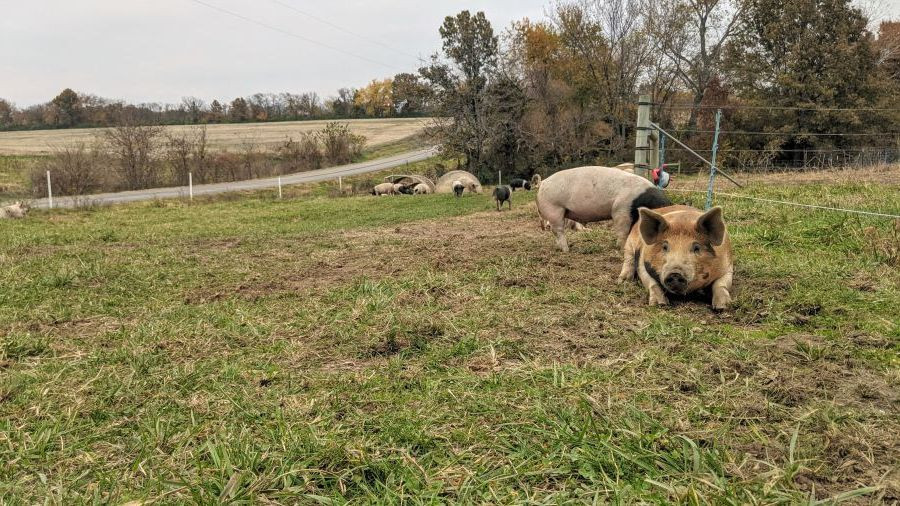Why I Choose Grass-Fed & Finished Beef (by Tracey Long, MPH, RDN)
posted on
April 9, 2024
Hey guys, Remi here! This is a post from Tracey Long's blog that she gave me permission to share here. She works in integrative and functional nutrition at Big Picture Health. Tracey has seen many people's lives changed through their bettered understanding of food, including her own. Enjoy this article, and feel free to reach out to her if you are looking for guidance in your healing journey.

Pictured on left: Cows raised on pasture by the Bauman Family near Garnett, KS.
Pictured on right: Cows started on grass, but finished on grain/soy at a feedlot.
1. I believe in supporting local food, small family farmers and the economy. The average miles our food travels to reach our dinner plates is about 1,500 miles1. When we eat local we conserve fuel, keep our food dollars local and can have a personal connection to the farmer and how our food is raised. I subscribe to the mantra, know your farmer, know your food.
Know your farmer, know your food
2. Cows are biologically meant to eat grass and pasture, not grains like corn or legumes like soy. When you feed an animal the food that it is biologically set up for it will be healthier. Cows are four-legged ungulates best adapted to graze on forage. The digestive system of cows, the four stomachs they have that we learned about in basic biology, are meant to ferment forage. Grains like corn and legumes like soy are used as high energy-dense food alternative for cows to put weight on them quickly for faster processing. This diet that is not congruent with the cow’s biology does work to speed up the process from start to finish, but can actually compromise the animal’s health. A review article by Calloway et al2 found that cows fed a diet high in grain had higher levels of the food-borne pathogen E. coli. When the diet was changed back to forage the E. coli levels were lowered within five days. A research study by Khafipour et al3 found that cows fed a diet based on grain became acidotic, and had high levels of lipopolysaccharides (LPS) that triggered inflammation and health problems in the cattle such as liver disease. These are two scientific examples of how grain can be unhealthy for cows.
3. Grazing cattle from start to finish is better for the environment and planet. You may be interested in reading the book by Judith Schwartz, “Cows Save the Planet.”4 Judith discusses how raising cows on pasture returns moisture and nutrients to the soil and, therefore; our food. Cattle feedlots are also a significant source of environmental pollutants such as antibiotics that affect downstream aquatic life and hormones that end up in the drinking water supply as additional examples.5,6 Feedlots use antibiotics and hormones to encourage rapid and increased growth and require antibiotics to suppress illness due to the confined living space and large buildup of fecal matter. Pastured cows arguably have less negative impact and even reported positive impacts on the environment.
4. I believe in respecting and honoring the animals I eat. As humans we have the capacity to treat animals poorly for our benefit (food) or treat them in a thankful manner for the nourishment they provide us. Joel Salatin, a well-known sustainable farmer in Swope, Virginia, said in a magazine interview,
“Our first responsibility is to try to figure out what kind of a habitat allows them (cows) to fully express their physiological distinctiveness. The cow doesn’t eat corn; she doesn’t eat dead cows; she doesn’t eat cow manure, which is what is currently being fed to cows in the industrial food system. We feed cows grass, and that honors and respects the cow-ness of the cow.7” Joel Salatin
5. Pasture raised and finished beef has a healthier fatty acid profile than conventional beef. The standard American diet is high in omega 6 fatty acids relative to omega 3 fatty acids. The problem is that omega 6 fatty acids, when out of balance with omega 3’s are highly inflammatory to the human body. Inflammation is now known to be the root of many chronic diseases. The good news is that the fatty acid composition of grass fed and finished beef is higher in the beneficial and anti-inflammatory omega 3 fatty acids than grain-fed beef. A study by MacAfee et al found that people who ate grass-fed meat had higher levels of the anti-inflammatory omega 3’s when their blood was tested for this healthy fat.8

Meet David and his [second] son Reeves, of David’s Pasture, from Concordia, MO.
I am grateful for the opportunity to purchase quality meat, pork, poultry and eggs from a farming family like Dave’s. Dave’s cattle are raised on pasture and get to express their, “cow-ness,” as Joel Salatin would say. Dave shared with me that he even feeds his cattle organic apple cider vinegar to improve their gut health and does not use hormones or antibiotics. His cattle fertilize the land they forage on and he rotates their grazing to promote healthy soil. Yes, I pay more for the products I buy from Dave than I would pay at the local grocery store, but for the reasons I listed above I know the price is worth it!
Original post by Tracey Long, MPH, RDN at Big Picture Health. Specializing in integrative and functional nutrition.
Re-posted here by Remington Kesten, David's Pasture. Grass-fed & finished Beef delivered to your door.



